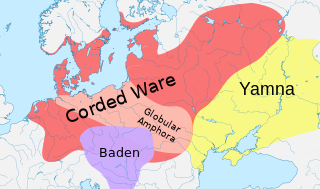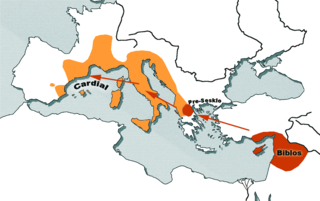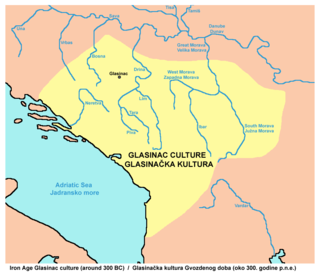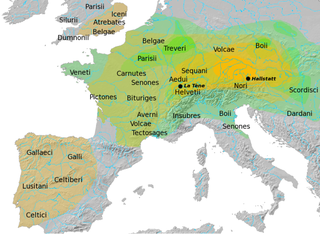 W
WThe Baden culture was a Chalcolithic culture from c. 3520–2690 BC. It was found in Central and Southeast Europe, and is in particular known from Moravia, Hungary, Poland, Slovakia, northern Serbia, western Romania and eastern Austria. Imports of Baden pottery have also been found in Germany and Switzerland.
 W
WThe Bijelo Brdo culture or Bjelo-Brdo culture is an early medieval archaeological culture flourishing in the 10th and 11th centuries in Central Europe. It represents a synthesis of the culture introduced in the Carpathian Basin by the conquering Hungarians around 900 and of earlier cultures existing in the territory before the Hungarian conquest. Female dress accessories, including "jewellery of plaited wire, two-piece sheetwork pendants, snake-head bracelets and S-shaped temple-reings", are the most characteristic items of the culture. The culture disappeared around 1100, most probably not independently of laws adopted under Kings Ladislaus I and Coloman of Hungary which prescribed the burial of dead in graveyards developed near churches.
 W
WCardium pottery or Cardial ware is a Neolithic decorative style that gets its name from the imprinting of the clay with the heart-shaped shell of the Corculum cardissa , a member of the cockle family Cardiidae. These forms of pottery are in turn used to define the Neolithic culture which produced and spread them, commonly called the "Cardial culture".
 W
WThe Castellieri culture developed in Istria during the Mid-Bronze Age, and later expanded into Friuli, Istria, Dalmatia and the neighbouring areas. It lasted for more than a millennium, from the 15th century BC until the Roman conquest in the 3rd century BC. It takes its name from the fortified boroughs, Castellieri, which characterized the culture.
 W
WDanilo culture was a Neolithic culture of the Dalmatian coast of Croatia and parts of Bosnia, dating to 4700-3900 BC.
 W
WThe Epigravettian was one of the last archaeological industries and cultures of the European Upper Paleolithic. It emerged after the Last Glacial Maximum around ~21,000 cal. BP and is considered to be a cultural derivative of the Gravettian culture. Initially named Tardigravettian in 1964 by Georges Laplace in reference to several lithic industries, found in Italy it was later renamed in order to better emphasize its independent character.
 W
WThe Glasinac-Mati culture is an archaeological culture, which first developed during the Late Bronze Age and Early Iron Age in the western Balkan Peninsula in an area which encompassed much of modern Albania to the south, Kosovo to the east, Montenegro, southeastern Bosnia and Herzegovina and parts of western Serbia to the north. It is named after the Glasinac and Mati type site areas, located in Bosnia-Herzegovina and Albania respectively.
 W
WThe Hallstatt culture was the predominant Western and Central European culture of Late Bronze Age from the 12th to 8th centuries BC and Early Iron Age Europe from the 8th to 6th centuries BC, developing out of the Urnfield culture of the 12th century BC and followed in much of its area by the La Tène culture. It is commonly associated with Proto-Celtic populations. Older assumptions of the early 20th century of Illyrians having been the bearers of especially the Eastern Hallstatt culture are indefensible and archeologically unsubstantiated.
 W
WThe La Tène culture was a European Iron Age culture. It developed and flourished during the late Iron Age, succeeding the early Iron Age Hallstatt culture without any definite cultural break, under considerable Mediterranean influence from the Greeks in pre-Roman Gaul, the Etruscans, and Golasecca culture, but whose artistic style nevertheless did not depend on those Mediterranean influences.
 W
WThe Lengyel culture is an archaeological culture of the European Neolithic, centered on the Middle Danube in Central Europe. It flourished from 5000 to 4000 BC, ending with phase IV, e.g., in Bohemia represented by the 'Jordanow/Jordansmühler culture'. It is followed by the Funnel Neck Beaker/TrB culture. The eponymous type site is at Lengyel in Tolna county, Hungary.
 W
WThe Middle-Danube Urnfield culture was a late Bronze Age culture of the middle Danube region.
 W
WThe Sopot culture is a neolithic archaeological culture in eastern Slavonia in modern day Croatia. It was a continuation of the Starčevo culture and strongly influenced by the Vinča culture. It spread into northern Bosnia from its original area to the west to northwestern Croatia and to the north to Hungarian Transdanubia, where it helped Lengyel culture start. The culture dates to around 5000 BC. Settlements were raised on the river banks. Houses were square and made of wood using interlace technique, sometimes separated into multiple rooms. Artefacts include many weapons made of bone, flint, obsidian and ironed volcanic rocks and some ceramic pottery of various sizes decorated by carvings or light stabbings and painting.
 W
WThe Starčevo culture is an archaeological culture of Southeastern Europe, dating to the Neolithic period between c. 6200 and 4500 BCE. It originates in the spread of the Neolithic package of peoples and technological innovations including farming and ceramics from Anatolia to the area of Sesklo. The Starčevo culture marks its spread to the inland Balkan peninsula as the Cardial ware culture did along the Adriatic coastline. It forms part of the wider Starčevo–Körös–Criş culture which gave rise to the central European Linear Pottery culture c. 700 years after the initial spread of Neolithic farmers towards the northern Balkans.
 W
WThe Urnfield culture was a late Bronze Age culture of Central Europe, often divided into several local cultures within a broader Urnfield tradition. The name comes from the custom of cremating the dead and placing their ashes in urns which were then buried in fields. Over much of Europe, the Urnfield culture followed the Tumulus culture and was succeeded by the Hallstatt culture. Some linguists and archaeologists have associated this culture with the Proto-Celtic language, or a pre-Celtic language family.
 W
WThe Vatin culture is a name of an prehistoric Bronze Age culture, which was named after village Vatin in Serbia. The culture had Indo-European roots and was culturally connected with Mycenaean Greece. The Vatin culture is dated to the middle Bronze Age and it is generally divided into three phases: Pančevo-Omoljica, Vatin-Vršac, and Belegiš-Ilandža. It flourished from 16th to 13th century BC.
 W
WThe Vinča culture, also known as Turdaș culture or Turdaș–Vinča culture, was a Neolithic archaeological culture in southeastern Europe, in present-day Serbia, and smaller parts of Bulgaria, Kosovo, North Macedonia, Greece and Romania, dated to the period 5700–4500 BC or 5300–4700/4500 BC. Named for its type site, Vinča-Belo Brdo, a large tell settlement discovered by Serbian archaeologist Miloje Vasić in 1908, it represents the material remains of a prehistoric society mainly distinguished by its settlement pattern and ritual behaviour.
 W
WThe Vučedol culture flourished between 3000 and 2200 BCE, centered in Syrmia and eastern Slavonia on the right bank of the Danube river, but possibly spreading throughout the Pannonian plain and western Balkans and southward. It was thus contemporary with the Sumer period in Mesopotamia, the Early Dynastic period in Egypt and the earliest settlements of Troy. Some authors regard it as Bell Beaker during the Kurganization of Europe.